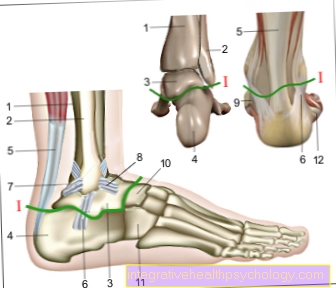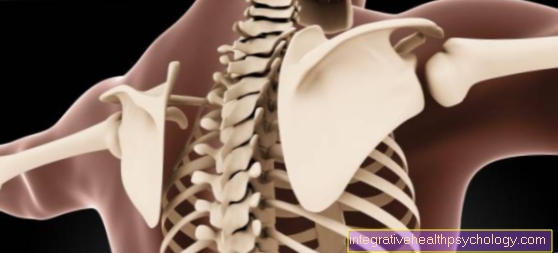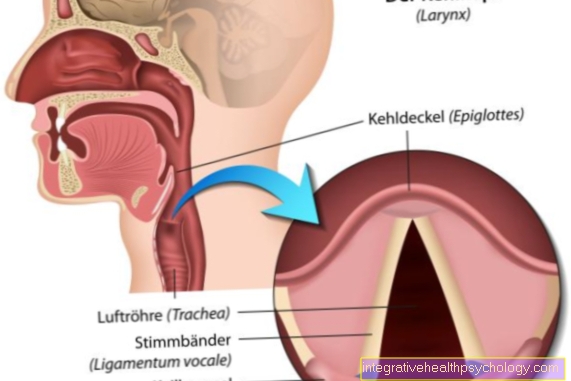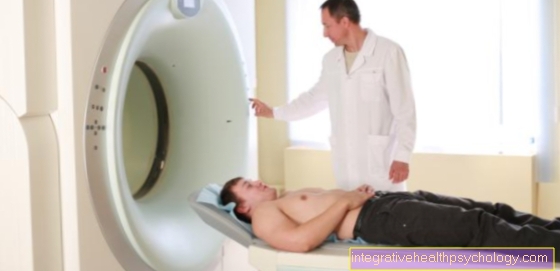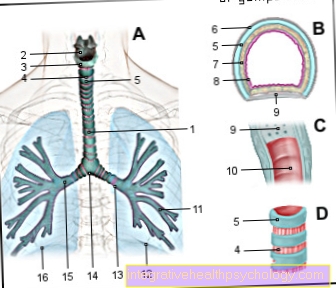The stages of cirrhosis of the liver
introduction
Liver cirrhosis is an irreversible disease and damage to liver tissue that can occur as a result of a wide variety of chronic liver diseases.
The liver is an organ of the upper abdomen that takes on numerous vital functions of the body such as detoxification functions or the production of various hormones and substances that promote coagulation. Liver diseases such as inflammation or alcohol-related remodeling processes can lead to structural changes in the liver cells and a remodeling into connective tissue, whereby the function of the liver is progressively restricted.

At the beginning of the disease, healthy parts of the liver can compensate for and compensate for the lost functions. Serious symptoms and secondary diseases only occur when most of the liver has lost its function.
The changes will be determined based on symptoms, blood counts and other medical examinations. In order to be able to diagnose the extent of the liver damage more precisely, a number of the values collected are assigned to the so-called "Child-Pugh Classification" summarized. This includes three grades of liver cirrhosis, with grade "Child C" being associated with the worst prognosis.
also read: Is cirrhosis of the liver curable?
Stage Child A
Child A grade describes cirrhosis of the liver that is not yet clinically advanced.
The division of the classification includes, for example, the albumin and bilirubin concentrations in the blood, but also the state of blood clotting. In addition, the presence of ascites and an associated brain impairment worsen the degree of liver cirrhosis.
In a Child A stage, all of these values can be in the normal range, so that the healthy parts of the liver fully compensate for the loss of function of the cirrhotic liver.
The prognosis for survival at this stage is normal and further liver damage can be halted by eliminating the underlying cause.
Also find out about: Water in the stomach
Stage Child B
Stage Child B describes a more advanced degree of liver cirrhosis, which is already associated with changes in laboratory values and often with noticeable symptoms and complaints.
Based on the 5 criteria of the classification, a number of points can be calculated according to which the stages are awarded. In stage B, slight to strong changes must be found in several categories.
It can be
- increased albumin and bilirubin levels,
- a slowdown in blood clotting or
- the appearance of ascites or
- cognitive and neurological limitations
act through cirrhosis of the liver.
The liver function can no longer be completely compensated for by healthy liver cells, so that further symptoms must also be expected.
Through therapeutic measures, the remodeling processes of the liver can still be stopped to a certain extent, so that the annual survival rate is still around 85%. Nonetheless, it is a life-threatening and very advanced disease.
You might also be interested in: Liver values in the blood count - what are they and what do they mean?
Stage Child C
Stage Child C is the final stage in the classification of liver function. There are already considerable deficits in the liver's filter and production functions.
In almost all criteria, which include the most important liver functions, there are severe restrictions that are associated with considerable symptoms, secondary complaints and consequences.
Cirrhosis of the liver in stage Child C is a serious clinical picture which can be fatal at any time. Functional liver cells are so limited that the vital functions can no longer be compensated, so that even the therapy of the underlying disease does not provide any prospect of treating the liver disease.
At this stage, only liver transplantation is still a promising therapeutic approach.
The 1-year survival rate in stage C is about 35%.
Hepatic encephalopathy
Hepatic encephalopathy is a neurological disease that can be traced back to a deficient filter function of the liver. Almost all metabolic processes in the body produce toxic substances that are metabolized and rendered harmless by chemical reactions in the liver.
With advanced liver cirrhosis, however, toxic substances such as ammonia can accumulate in the body and lead to severe functional disorders in the brain. This is a typical complication of a severely advanced liver disease, which in turn can be divided into 4 stages. These stages result primarily from the severity of the neurological symptoms.
Read on below: Symptoms of cirrhosis of the liver
Encephalopathy stage 1
Stage 1 is associated with only mild, unspecific neurological symptoms. These express themselves primarily as
- Fatigue,
- Concentration problems and
- Mood swings with irritability.
The transitions to other stages of hepatic encephalopathy are fluid. In the meantime, symptom-free phases can occur that can only be recognized by increased ammonia levels. If necessary, it may worsen in higher stages.
Coarse, irregular tremors with outstretched arms and hands are also typical, which typically correlates with the severity of the encephalopathy. Stage 1 can usually be treated on an outpatient basis, whereby the excretion of toxins must be increased with medication.
Encephalopathy stage 2
In stage 2, the neurological symptoms of hepatic encephalopathy can be significantly more advanced. The symptoms of fatigue and difficulty concentrating are exacerbated, being in addition to it
- Lethargy,
- Indifference,
- complete numbness and
- Confusion can arise.
- The first motor changes can also be seen in the form of increased tremors,
- as well as a deterioration of the typeface noticeable.
From this stage onwards, inpatient treatment is indicated, as accompanying bleeding or inflammation due to infections is often the cause.
Encephalopathy stage 3
Stage 3 of hepatic encephalopathy is already a considerably advanced clinical picture with life-threatening functional restrictions of the brain, which can lead to severe consequential damage.
The disturbance of consciousness has often progressed to marked drowsiness, but at which the patient can still be awakened. Additionally it comes to
- significant speech disorders,
- motor restrictions,
- severe confusion and
- an increase in gross tremor of the hands.
The transition to stage 2 can be fluid.
Encephalopathy stage 4
The most important distinction between stage 3 and stage 4 of hepatic encephalopathy is impaired consciousness. Stage 4 is usually a coma from which the affected person cannot be awakened either by speaking or by painful stimuli.
Initially, reactions such as untargeted defense reactions or pulse accelerations can occur in response to pain stimuli. The prognosis for this stage can be very different, but the high blood levels of the toxic molecules can cause permanent damage.
Recommendations from the editorial team
You might also be interested in these topics:
- Diet in cirrhosis of the liver
- Symptoms of cirrhosis of the liver
- Therapy of cirrhosis of the liver
- Hepatic insufficiency




